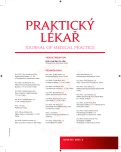-
Medical journals
- Career
Sinus pilonidalis sacrococcygealis
Authors: J. Zímová 1; H. Bačuvčíková 2; P. Zímová 3
Authors‘ workplace: Kožní ambulance, Středomoravská nemocniční a. s. – Nemocnice Přerov, o. z., Primář: prim. MUDr. Pavel Zíma 1; Chirurgické oddělení, Středomoravská nemocniční a. s. – Nemocnice Přerov, o. z., Primář: prim. MUDr. Stanislav Kalabus 2; Ústav ochrany a podpory zdraví LF MU Brno, Přednostka: prof. MUDr. Bc. Zuzana Derflerová Brázdová, DrSc. 3
Published in: Prakt. Lék. 2015; 95(2): 73-76
Category: Of different specialties
Overview
The authors transparently analyse in the article the disease pilonidal sinus whose incidence in the Czech Republic reaches between 26/100 000 inhabitants. Men are more afflicted by the disease than women. Ethiopathogenesis is not still explained. In pathophysiology of the disease hair fulfils the key role. Only 35–50% of sick people look up the doctor. The clinical picture of the disease is varied. The diagnostics comes out from the inspection, palpation and probing the sinus. The surgeon leads the therapy, the dermatovenerologist can fulfil the disease by laser depilation of hypertrichosis in the intergluteal area. The disease has a specific character, it lowers the quality of the patients’ life and it causes them the psychological problems. Interdisciplinary cooperation of the surgeon and the dermatovenerologist is essential in the frame of the diagnostics and the therapy.
Keywords:
pilonidal sinus – hair – interdisciplinary cooperation
Sources
1. Adamová Z, Bár T. Sinus pilonidalis v primární péči. Postgrad Med 2012; 14(9): 1036–1039.
2. Akin O, Sadullah G, Murat K, et al. Pilonidal sinus disease: risk factors for postoperative complications and recurrence. Int Surg 2012; 97 : 224–229.
3. Anděl P, Škrovina M, Ducháč V. Základy praktické proktologie. Praha: Galén 2012; 75–80.
4. Barnhill RL, Crowson NA, Magro CM, Piepkorn MW. Dermatopathology. Third Edition. USA: McGraw Hill Companies 2010; 553.
5. Burnst T, Breanthnach S, Cox N, Griffiths Ch. Rook’s textbook of dermatology. Eighth edition. Vol. 4, Chapter 71 The Genital, Perianal and umbilical regions. UK: Willey Blackwell 2010; 3786–3803.
6. Coskun A, Bulus H, Akinci ÖF, Özgönül A. Ethiological factors in umbilical pilonidal sinus. Indian J Surg 2011; 73(1): 54–57.
7. Ganjoo A. Laser hair reduction for pilonidal sinus – my experience. J Cutan Aesthet Surg 2011; 4(3): 196.
8. Ghnnam WM, Hafez DM. Laser hair removal as adjunct to surgery for pilonidal sinus: our initial experience. J Cutan Aesthet Surg 2001; 4(3): 192–195.
9. Harlak A, Mentes O, Kilic S, et al. Sacrococcygeal pilonidal disease: Analysis of preivously proposed risk factors. Clinics 2010; 65(2): 125–131.
10. Horák L, Skřička T, Šlauf P, Örhalmi J. Praktická proktologie. Praha: Grada Publishing 2013; 163–169.
11. Mentes O, Oysul A, Harlak A, et al. Ultrasonography accurately evaluates the dimension and shape of the pilonidal sinus. Clinics 2009; 64(3): 198–192.
12. Sunkara A, Wagh DD, Harode S. Intermammary pilonidal sinus. Int J Trichology 2010; 2(2): 116–118.
13. Štork J. Dermatovenerologie. 2. vydání. Praha: Galén 2013; 425.
14. Zeman M. a kol. Speciální chirurgie. 2. vydání. Praha: Galén 2004; 309.
Labels
General practitioner for children and adolescents General practitioner for adults
Article was published inGeneral Practitioner

2015 Issue 2-
All articles in this issue
- Dog’s olfactory system in medicine and human malignant or other diseases
- Job dissatisfaction of nurses in the Czech Republic
- What to tell patients about e-cigarettes?
- Hagiotherapy as a component method of psychotherapy
- Sinus pilonidalis sacrococcygealis
- Alcohol in primary health care: experiences and attitudes of Czech general practitioners
- Pseudotumor cerebri
- A personality of Czech anatomy and pathology of the 19th century: Vincenc Alexandr Bochdalek
- General Practitioner
- Journal archive
- Current issue
- Online only
- About the journal
Most read in this issue- Sinus pilonidalis sacrococcygealis
- Pseudotumor cerebri
- Job dissatisfaction of nurses in the Czech Republic
- Alcohol in primary health care: experiences and attitudes of Czech general practitioners
Login#ADS_BOTTOM_SCRIPTS#Forgotten passwordEnter the email address that you registered with. We will send you instructions on how to set a new password.
- Career

